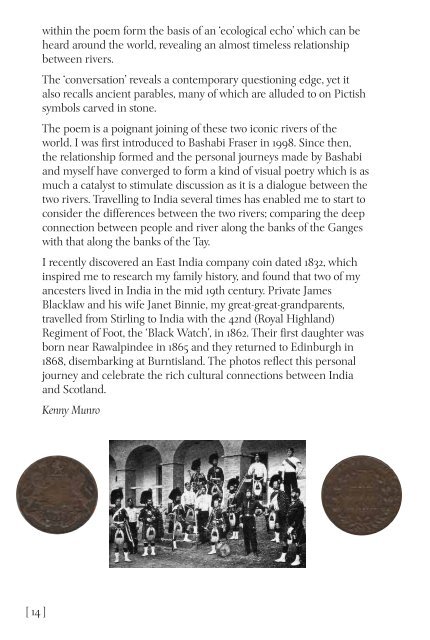From the Ganga to the Tay by Bashabi Fraser sampler
The Ganges and the Tay, the largest water courses in their two countries, are sources of life, conflict and industrial and historical change. The Ganga and the Tay is an epic concrete poem in which the River Ganges and the River Tay relate the historical importance of the ties between India and Scotland and their contemporary relevance as a natural symbol of continuity and peace. The poem is illustrated with beautiful photographs of both great rivers, which explore their shared, but unique, personalities through their histories, geographies, mythologies and environments.
The Ganges and the Tay, the largest water courses in their two countries, are sources of life, conflict and industrial and historical change. The Ganga and the Tay is an epic concrete poem in which the River Ganges and the River Tay relate the historical importance of the ties between India and Scotland and their contemporary relevance as a natural symbol of continuity and peace. The poem is illustrated with beautiful photographs of both great rivers, which explore their shared, but unique, personalities through their histories, geographies, mythologies and environments.
You also want an ePaper? Increase the reach of your titles
YUMPU automatically turns print PDFs into web optimized ePapers that Google loves.
within <strong>the</strong> poem form <strong>the</strong> basis of an ‘ecological echo’ which can be<br />
heard around <strong>the</strong> world, revealing an almost timeless relationship<br />
between rivers.<br />
The ‘conversation’ reveals a contemporary questioning edge, yet it<br />
also recalls ancient parables, many of which are alluded <strong>to</strong> on Pictish<br />
symbols carved in s<strong>to</strong>ne.<br />
The poem is a poignant joining of <strong>the</strong>se two iconic rivers of <strong>the</strong><br />
world. I was first introduced <strong>to</strong> <strong>Bashabi</strong> <strong>Fraser</strong> in 1998. Since <strong>the</strong>n,<br />
<strong>the</strong> relationship formed and <strong>the</strong> personal journeys made <strong>by</strong> <strong>Bashabi</strong><br />
and myself have converged <strong>to</strong> form a kind of visual poetry which is as<br />
much a catalyst <strong>to</strong> stimulate discussion as it is a dialogue between <strong>the</strong><br />
two rivers. Travelling <strong>to</strong> India several times has enabled me <strong>to</strong> start <strong>to</strong><br />
consider <strong>the</strong> differences between <strong>the</strong> two rivers; comparing <strong>the</strong> deep<br />
connection between people and river along <strong>the</strong> banks of <strong>the</strong> Ganges<br />
with that along <strong>the</strong> banks of <strong>the</strong> <strong>Tay</strong>.<br />
I recently discovered an East India company coin dated 1832, which<br />
inspired me <strong>to</strong> research my family his<strong>to</strong>ry, and found that two of my<br />
ancesters lived in India in <strong>the</strong> mid 19th century. Private James<br />
Blacklaw and his wife Janet Binnie, my great-great-grandparents,<br />
travelled from Stirling <strong>to</strong> India with <strong>the</strong> 42nd (Royal Highland)<br />
Regiment of Foot, <strong>the</strong> ‘Black Watch’, in 1862. Their first daughter was<br />
born near Rawalpindee in 1865 and <strong>the</strong>y returned <strong>to</strong> Edinburgh in<br />
1868, disembarking at Burntisland. The pho<strong>to</strong>s reflect this personal<br />
journey and celebrate <strong>the</strong> rich cultural connections between India<br />
and Scotland.<br />
Kenny Munro<br />
[ 14 ]


















